Capacity Building
Kerala State Council For Science, Technology And Environment (KSCSTE)
Kerala State Council for Science, Technology and Environment (KSCSTE) is an autonomous body under the Department of Science & Technology, Government of Kerala, constituted in November 2002 to act as an agency for change and development through science and technology. Established in 1972 as Science, Technology and Environment Committee (STEC), in accordance with the Science Policy of Government of Kerala, the STEC was reconstituted as KSCSTE in 2002 and is governed by the State Council (SC) with the Chief Minister of Kerala as the President and an Executive Council (EC), chaired by the Executive Vice President (EVP) of KSCSTE. Presently, there are seven full-fledged R&D centres, two emerging research centres and two Grant-in-aid institutions under the umbrella of KSCSTE.
Major objectives of KSCSTE
The objectives behind the setting up of the council include the following;
- to identify thrust areas in science and technology for speeding up the socio-economic development and enhancing the quality of life and environment in Kerala
- to advise the Government on the formulation of policies and strategies and suggest measures for implementation, which will promote the application of science and technology to meet the perceived needs of the society, and manage natural resources
- to assist in the preparation of the Science and Technology Development Plan of the State and its implementation
- to promote effective coordination between Centres of Scientific and Technological research, Government agencies, farms and industries including the private sector so that know-how generated by scientific research is fruitfully deployed by transfer of technology
- to support and coordinate research programmes in the universities and institutes of the Government, research and development laboratories of the private sector with a view to optimizing the scientific output
- to consider and advise the Government on all such matters as are relevant to the application of science and technology to the economic, industrial, educational and social development of Kerala
- to advise local self-governments on the use of Science & Technology for local application and local development
- to network the Science and Technology agencies within and outside the country
- to make the Science, Technology and Environment plans responsive to the development needs of Kerala and to detail them with the programmes of the economic, scientific and service departments of the Government such as agriculture, industries, power, water, energy, education and IT
The main objective of KSCSTE, therefore, is to plan and formulate science, technology and innovation policy pertaining to the development of the State. The schemes and programmes of the Council are also aimed at development of high quality science education system in the State through infrastructure strengthening for basic research and promotion of science pedagogy.
Kerala State Council for Science Technology and Environment drives Research and Development efforts of the R&D Centres through offering assistance for creation of physical infrastructure and procurement of scientific infrastructure under Development and Selective Augmentation of R&D activities. The other initiatives include the following:
- Science Popularisation Programmes
- Research Development Programmes
- Ecology and Environment Programmes
- Awards and Recognition for science promotion
- Technology development and transfer
- School level promotions
The KSCSTE takes deliberate efforts to popularize science including basic science, applied science, technology, environmental science, medical science and related areas among people with the assistance of Governmental and Non Governmental organizations, colleges and approved institutions. National Science Day and National Technology Day are observed to spread the message of importance of science and its application among the people. Seminar-Symposia-Workshops, Technology Festival, Rural Innovators Meet and Kerala Science Congress were conducted to facilitate interaction among academics, researchers, professionals, industry and decision makers.
Technology development and transfer is promoted through Patent Information Centre, Engineering and Technology Programmes, Technology Development and Adaptation Programme, and Rural Technology Programmes.
The Council extends awards and recognition to promote science and technology and promote scientific attitude among youngsters. Kerala Sasthra Puraskaram is for life time contribution of a Scientist of Kerala, working anywhere in the world. In addition to this, the Council extends Young Scientist Award, Science Literature Awards, Environment Early Career Research Award and Outstanding Environment Award to promote science and technology.
Major Arms of KSCSTE for Scientific Research
There are seven R&D centres under the umbrella of the Council which conducts Research and Development activities in specific mandated domains.
Kerala Forest Research Institute (KFRI)
Founded in 1975, the institute has contributed significantly to the research in tropical forestry and biodiversity conservation over the past four decades of its existence. KFRI started functioning under STEC and became a part of KSCSTE in 2002. The institute is envisioned as a Centre of Excellence in Tropical Forestry to provide scientific support for decision making on matters related to forestry, with particular emphasis on conservation, sustainable utilization and scientific management of natural resources.
Sustainable management of forests requires a strong science and technology base. It requires a shift in thrust for forest management assigning greater importance to the environmental functions of forests. Working in collaboration with the Forest department and other stakeholders, the Kerala Forest Research Institute continues to play a key role in improving the science foundation of forest management.
Major achievements
- The Institute is considered as an International Centre of Excellence in Tropical Forestry.
- Two major international research initiatives are based in the Institute. One is ‘Teaknet’ (International network of institutions and individuals interested in teak), and the secretariat of the network is located in KFRI and second is ‘APFISN’ (Asia –Pacific Forest Invasive Species Network). The office of the ÁPFISN’ functions at KFRI. The Network is a cooperative alliance of the 33 member countries in the Asia- Pacific Forestry Commission (APFC) - a statutory body of the Food and Agriculture Organization of the United Nations (FAO). The network focuses on inter-country cooperation that helps to detect, prevent, monitor, eradicate and/or control forest invasive species in the Asia-Pacific region.
- Government of India had identified KFRI as one of the organization for imparting training to the officers of the Indian Forest Service (IFS) from the various States.
- Developed HpNPV Technology; Hyblaea Puera (National Patent) for Bio control & Teak Defoliator; Developed a technology for converting weeds to good quality organic manure using ‘Jeevamrutham’ and another to convert urban organic waste to good organic manure using ‘Jeevamrutham’.
National Transportation Planning and Research Centre (NATPAC)
National Transportation Planning and Research Centre (NATPAC) was established in 1976 as a Division of Kerala State Electronics Development Corporation (KELTRON), a Public Sector Enterprise under the Government of Kerala. In 1982, NATPAC was reconstituted as an R&D institution under the Department of Science, Technology and Environment, Government of Kerala. NATPAC became a part of KSCSTE in 2002. The Centre is undertaking research and consultancy works in the fields of traffic engineering and transportation planning, highway engineering, public transport system, alternate options for transport system, transport energy, inland water transport, tourism planning and rural roads. The activities of NATPAC range from surveying to preparation of technoeconomic studies, feasibility analysis, detailed project reports for infrastructure development projects involving multi-modal system of transportation covering road, rail, water, ports/harbours and airports. Currently, NATPAC has 7 scientific divisions.
Major Achievements
- Developed a scientific formula for fixation of fare for bus operations
- Developed a trip generation model for identified towns in Kerala using “quick response”concept
- The influence of platoon movement of buses from Signalized Junctions to down -stream bus bays
- Studied the impact of proposed Vizhinjam seaport on the Traffic and Transportation systems of hinterland areas
- Identified possible road map for initial implementation of greener transport in Technopark campus at Thiruvananthapuram leading to large scale use of greener transport modes in the State
- Studied the existing pedestrian facilities and infrastructure in selected road corridors of Thiruvananthapuram and Kochi cities in Kerala and formulated strategies to enhance better accessibility, convenient and safe walking environment
- Carried out an appraisal of the highways developed under Kerala State Transport Project (KSTP) by conducting the structural and functional evaluation
- Developed a traffic growth rate model for the National Highways in Kerala
- Assessed the feasibility of connectingNW-3 with Thrissur town through waterways
- Formulated accident prediction models
- Prepared Road Safety Training Materials which includes Books, Booklets, Calendars, Leaflets, Stickers and display boards
- Developed 18 films related to different aspects on road safety targeting different rod users and also developed a mobile application on android platform on road Safety named “Safesavari”
Centre for Water Resources Development and Management (CWRDM)
CWRDM is a premier R & D institution in the water sector under KSCSTE. Recognising the need for catering to the R & D needs in the field of water management, the Centre for Water Resources Development and Management (CWRDM) was established as an autonomous research organisation by the Government of Kerala, under its Science and Technology Policy in February 1978. The Centre was amalgamated with the Kerala State Council for Science, Technology and Environment (KSCSTE) in its Silver Jubilee Year (2003). CWRDM has substantially contributed to the scientific hydrologic studies and water management in the region. The Centre provides research inputs for water resources development and management, especially in the humid tropics and has expertise in tackling different problems pertaining to watershed development, wetland management, water management for agriculture, forest and urban hydrology, estuarine management, groundwater development, water quality management, water related environmental issues and irrigation and drainage issues. The Centre is proud to have many ongoing and completed programmes funded by national and international agencies including Government of India, United Nations Development Programme, United Nations Environment Programme, UNICEF, World Bank and National Academy of Sciences (USA). Presently, CWRDM has 10 scientific divisions and 3 extension centres.
Jawaharlal Nehru Tropical Botanic Garden and Research Institute (JNTBGRI)
Jawaharlal Nehru Tropical Botanic Garden and Research Institute (JNTBGRI) formerly known as Tropical Botanic Garden and Research Institute (TBGRI) was founded as an autonomous institution in 1979 with the objective of establishing a Conservatory Botanic Garden of tropical plant resources in general and of the country and the Kerala State in particular. It also undertakes research programmes for the sustainable utilization of these resources. The institute is located in 300 acres of natural forestland, right in the lap of the Western Ghats of Palode, 40 km northeast to Thiruvananthapuram city.
The institute is currently conserving more than 4000 species of flowering plants and about 300 species of non-flowering angiosperms, which is the highest number of plant species conserved among the botanic gardens in Asia. The institute has an extension centre viz., Saraswathy Thangavelu Centre at Puthenthope, Thiruvananthapuram where the Bioinformatics Centre is established. The Government of India has recognized the JNTBGRI as a National Centre of Excellence.
Presently, the institute has 9 scientific divisions involved in research activities including ex-situ conservation and management of plant wealth of the country, biodiversity documentation, systematic studies, conservation and management, bio prospecting (biotechnological, phytochemical and pharmacological) of plants for sustainable utilisation, documentation of indigenous knowledge, education, extension and training on conservation and sustainable utilization of plants with financial assistance from different State and national funding agencies.
Kerala School of Mathematics (KSOM)
Kerala School of Mathematics (KSOM) was established in 2009 as a joint venture between KSCSTE, Government of Kerala and Department of Atomic Energy (DAE), Government of India for carrying out advanced learning and research in Mathematics. It is situated at Kunnamangalam near Kozhikode. KSOM aims to play a catalytic role in reviving the great mathematical tradition of Kerala in the modern paradigm. The school which aims to run as a national facility, envisages promotion of mathematical research in the country and Kerala in particular through activities such as research at doctoral and post-doctoral level, workshops in frontier areas of mathematical science, national and international conferences, instructional conferences, structured courses and lectures for young mathematicians, training for post-graduate students, research scholars and teachers.
Srinivasa Ramanujan Institute for Basic Sciences (SRIBS)
Srinivasa Ramanujan Institute for Basic Sciences (SRIBS) is a capacity building Institute envisaged for Research, Teaching and Learning in Basic Sciences. SRIBS was established by the Government of Kerala in 2013 at Kottayam. The main objective of the institute is to formulate and implement programmes for capacity building for young faculty members, researchers and post graduate students in contemporary areas of sciences.
The institute has organized several colloquia, seminars, workshops and symposia with the support of over 200 internationally acclaimed scientists from about 100 premier institutions around the world, benefiting over 1500 students, teachers and researchers in various areas of science.
Malabar Botanical Garden and Institute for Plant Sciences (MBGIPS)
The Malabar Botanical Garden & Institute for Plant Sciences (MBGIPS) is an institution of KSCSTE dedicated to the conservation and research on aquatic plant diversity, lower group plants, endangered plants of the erstwhile Malabar Region, as well as disseminating knowledge on various facets of plant sciences. MBGIPS is situated adjacent to Pokkunnu at Olavanna village in Kozhikode District.
The Garden is spread over an area of about 40 acres of which about 15 acres is marshy land and the remaining part is a hilly terrain providing diverse habitats for varieties of plants. The Malabar Botanical Garden and Institute for Plant Sciences is unique for ex situ conservation of aquatic/wetland plants and for undertaking research on them. A Systematics Garden, Aqua-conservatory, Hortus Malabaricus Garden, Rare, Endangered and Threatened (RET) species conservation, lower group conservatory are the highlights of the Garden. The Garden is open to students for eco-education and to general public as part of promoting scientific tourism in the region. The educational value of the Garden lies with the descriptive labels displayed for the different sections and plants. This institute is also a Research Centre in Plant Sciences (Botany) recognized by the University of Calicut.
Major Achievements
- Fellowship Titles of
- National Academy of Biological Sciences (FNABS)
- Gregor Mendel Foundation 2016 (FGMF)
- National Academy of Sciences, India 2016 (FNASc)
- Leadership Award of National Academy of Biological Sciences 2015
- Eminent Scientist of the Year Award of the International Foundation for Ecology & Environment in 2016
- Certificate of Appreciation 2015 for service (GMF)
- Best Microbiologist Award 2015 (SESR)
- Best Informative Pavillion Award, Global Ayurveda Festival 2016
- Best Science Expo Award in the 26th Kerala Science Congress
Academic Achievements of R and D Institutions
Research Publications
The Research and Development Institutions of KSCSTE have been creating the wealth of knowledge in diverse fields. The institutes have produced a good number of publications in refereed journals, published books and chapters in books and research papers in national and international conferences. The number of research papers produced by R&D Institutions from 2012 onwards is given in the Figure 7.1.
Figure 7.1
Research Papers Produced by R&D Institutions from 2012 -2016, in number
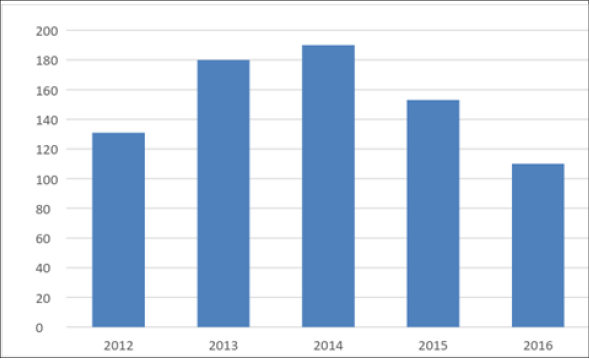
Source: KSCSTE, Sasthrabhavan, Thiruvananthapuram.
The number of research papers produced in 2016 is a quick estimate as on November 2016. Among the seven R&D institutions under the Council, JNTBGRI, CWRDM and KFRI rank at the top with respect to the publication of papers.
With respect to the publication of books during 2016-17, JNTBGRI has published 3 books and 1 chapter in an edited work. CWRDM has also published 1 book and 11 technical reports during the same period. KFRI has also published 2 books in the year 2016.
Other Schemes and programmes of KSCSTE
7.25 Science Research Scheme (SRS): It is one of the flagship activities of the Council operating under the Science and Technology Promotion Division (STDP) of the Council. SRS aims towards the promotion of R&D activities in the State both in fundamental and applied research. Under the scheme, research projects in emerging areas of science and engineering are supported by providing financial assistance for implementation. Research projects are supported in University departments, colleges and R&D institutions. The projects sanctioned under the scheme from 2012-13 to 2015-16 is given in Figure 7.2.
Figure 7.2
Projects sanctioned under the scheme- subject wise, in number
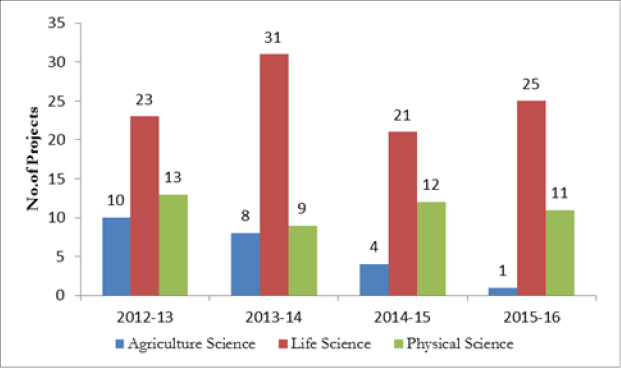
Source: KSCSTE, Sasthrabhavan, Thiruvananthapuram.
Figure 7.3 portrays the publications by the University Departments, Colleges and R&D Institutions under SRS during the 12th plan period.
Figure 7.3
Publications during 12th five year plan period under Science Research Scheme, in number
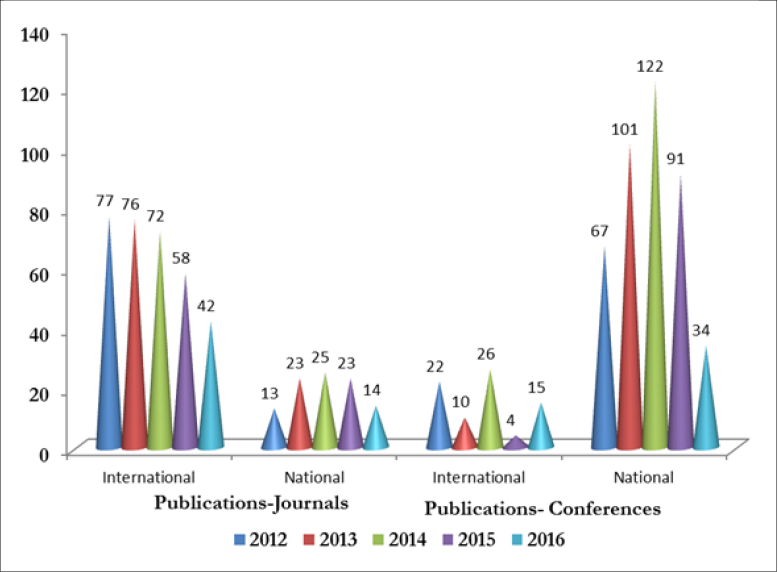
Source: KSCSTE, Sasthrabhavan, Thiruvananthapuram.
Achievements of KSCSTE Research Fellows
As per the data from KSCSTE, about 343 students have been facilitated to carry out Ph.D in Science since 2002. Several research fellows are placed in academic/ R&D institutions in India and abroad. Many of them bagged State level young scientist awards and best paper awards. Figure 7.4 shows the achievements of KSCSTE research fellows from 2013-15.
Figure 7.4
Achievements of KSCSTE research fellows during 2013-15, in number

Source: KSCSTE, Sasthrabhavan, Thiruvananthapuram.
Programmes For Infrastructure Development in S and T
In order to provide sufficient infrastructure facilities in universities, colleges and schools for the promotion of scientific activities and augmenting research, the Council has been providing financial assistance for the creation of lab and related facilities over there. Selective Augmentation of Research and Development (SARD) and Sastraposhini are the two schemes implemented by the Council for this purpose. SARD is envisaged to create facilities in colleges and universities for augmenting research in specified areas. Under this programme, grants will be paid for strengthening the laboratory infrastructure by procuring equipment and also for its maintenance. So far, 57 science Post Graduate laboratories and research institutions in Kerala have been augmented.
Sastraposhini scheme aims to establish model science laboratories in Physics, Chemistry and Biology to create a better ambience in high schools. Since the very inception of the scheme 179 schools in Government and aided sector in the State have been supported to establish good science laboratories.
Engineering and Technology Programmes (ETP)
The Engineering and Technology Programme (ETP) intends to encourage and promote research talents for the implementation of high quality research projects in the emerging areas of Engineering and Technology. The scheme is instituted for the faculty of engineering colleges and Scientists of R&D institutions in the State. Figure 7.5 represents the number of proposals received and approved under ETP from 2010-11 to 2015-16.
Figure 7.5
Proposals received and approved under ETP from 2010-11 to 2015-16, in number
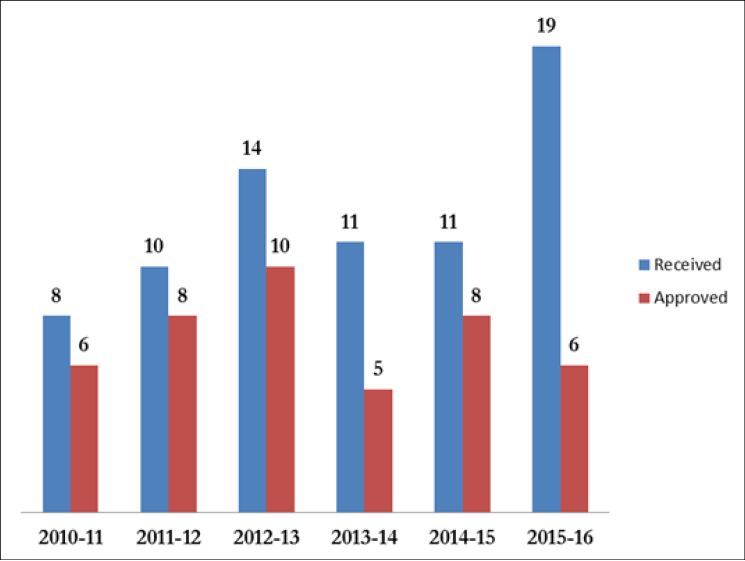
Source: KSCSTE, Sasthrabhavan, Thiruvananthapuram.
Technology Development and Adaptation Programme (TDAP)
The very objective of the programme is to provide catalytic support for the development and demonstration of innovative and need-based technologies and to raise such technologies to the level of commercialisation. Individual innovators who possess a professional degree (Diploma or Degree in Engineering or equivalent), students of professional technical courses, Scientists/Researchers from Research Organizations/Academic Institutions/Non- Governmental Organizations can apply under this scheme. During the year 2015-16, 14 proposals were received of which 5 were sanctioned.
Rural Technology Programme (RTP)
Rural Technology Programme (RTP) scheme is instituted for the purpose of providing assistance in the form of grants to promote and support the traditional rural technology and upgrade them, so that it could be perfected for wider applications and employment generation and to reduce the drudgery of the rural households. The main objectives of this scheme are to encourage and promote grassroot innovators and individuals to support them so as to perfect their innovative ideas in rural technology sector and provide technical support to raise their innovations to an enterprise level. Figure 7.6 portrays the type of institutions involved under the Rural Technology Programme.
Figure 7.6
Types of tie-up institutions involved, in per cent
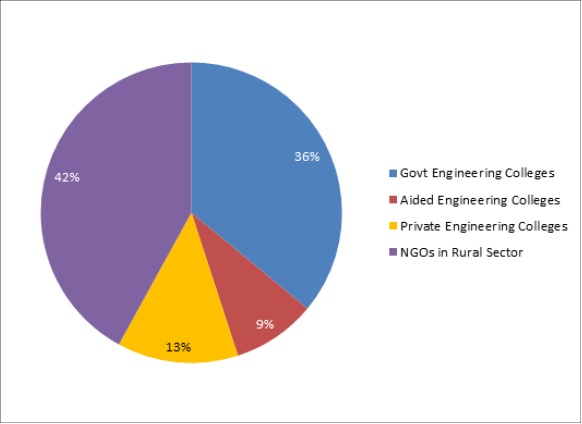
Source: KSCSTE, Sasthrabhavan, Thiruvananthapuram.
Patent Information Centre – Kerala (PIC-Kerala)
KSCSTE with the support of Dept. of Science & Technology, Government of India established Patent Information Centre – Kerala (PIC-Kerala) in the year 2003 to provide Intellectual Property Rights (IPR) related services to the people in the State of Kerala. PIC-Kerala has been implementing many programmes to promote and propagate IPR in the State through awareness campaigns and publications. The Centre has been guiding the inventors in protecting their intellectual properties and facilitates access to patent related documents. The ultimate objective of PIC-Kerala is to increase the IP output of the State. Table 7.1 gives the number of filed patent applications.
Table 7.1
Number of Patent Applications Processed
| Year | No. of Patent Applications | 2010 | 56 | 2011 | 74 | 2012 | 87 | 2013 | 89 | 2014 | 59 | 2015 | 60 | 2016 | 45 |
Source: KSCSTE, Sasthrabhavan, Thiruvananthapuram
Programmes for Women in Science
Though the State has the highest share of women literates, their representation in science research is very low. In order to provide a support system to attract and retain women and girls in science and take up science as a career, the Women Scientists Division at KSCSTE initiated several schemes and programmes to increase their participation in Science, Technology, Engineering, Agriculture and Medicine (STEAM). The important programmes carried out by the Council in this area are
- Women in Science
- Back to Lab Research Fellowship Programme
- Awareness Programme on “Technological advances in transforming women’s lives”
- Project on Preparation of database of ‘Women in Science in Kerala’.
- VSORT – Vocational Skill Oriented Reinstate Training
- STARS (Students with Talent and Aptitude for Research in Science)
- Pratibha Scholarship Scheme
- SPEED (Student Programme for Excellence in Experimental Design)
Government Spending on Scientific Services and Research
Recognising the growing need of investments and related expenditure for expansion of the scientific services and research in the State, the government have been allocating certain portion of its budgetary allocation from the fifth plan period onwards. During the fifth plan period (1974-78) the allocation was Rs. 7.98 crore and the figure rose to 436.44 crore by the 12th plan period (2012-17). Table 7.2 details the plan outlay and expenditure during the period 2012-13 to 2016-17.
Table 7.2
Plan outlay and Expenditure from 2012 to 2017, ` in lakh
| Year | Outlay | Expenditure | 2012-13 | 6620 | 6396.15 | 2013-14 | 7895 | 5136.93 | 2014-15 | 9171 | 5464.65 | 2015-16 | 9979 | 6362.20 | 2016-17 | 9979 | 2323.24* |
Source: Annual Plan Documents,
Stat e Planning Board, Thiruvananthapuram.* Expenditure up to November 30, 2016
Manpower Training
Ensuring sustainable pipeline of talented youth for science is a challenge. The role of R & D institutions in rearing up research aptitude and talent has foremost importance in orienting the youth to science, technology, innovations and S&T-based solutions that successfully lead an economy or a State. The R&D institutions of KSCSTE have produced 7 PhDs in 2016(as on October 2016 estimates). The institutes have trained 1174 manpower in Research capacities and 170 in technical capacities. Table 7.3 provides the performance of the R &D institutions collectively in providing quality manpower, and producing output in terms of patents and technology transferred.
Table 7.3
Performance of R & D Institutions, in number
| R & D Centre | 2012 | 2013 | 2014 | 2015 | 2016 | Ph D Produced | 12 | 10 | 11 | 12 | 7 | Research Manpower Trained (other than Ph D) | 171 | 1017 | 703 | 534 | 1174 | Technical Manpower Trained | 146 | 283 | 473 | 243 | 170 | Patent Filed | 1 | 1 | Nil | 1 | Nil | Technology Transferred | Use of waste plastic for road construction by NATPAC | 3 |
Source: KSCSTE, Sasthrabhavan, Thiruvananthapuram.
The Council has been taking serious efforts to promote excellence in science and technology through learning, research and development with the participation of academia, industry and research organizations. It is also receiving a substantial allocation from the government to boost up these activities. The advancements in the S&T sector will bring forth modernised development to all other sectors of the economy. This can be realised only by ensuring quality research, manpower, provision of equipment and necessary infrastructure and also through the involvement of practicing scientists and the university faculty in the R&D activities relevant to the State.
Regional Cancer Centre, Thiruvananthapuram
Regional Cancer Centre (RCC), Thiruvananthapuram was sponsored and established jointly by Government of India and Government of Kerala in 1981 as a grant-in-aid research institution for promoting cancer research and generating manpower in oncology as well as providing comprehensive cancer care. Its main objective is to undertake basic, applied and statistical research in various specialities of oncology.
Today, RCC is the premier, comprehensive, dedicated centre for diagnosis, treatment and control of cancer in Kerala. It is rated amongst the top three of the 28 Regional Cancer Centres in the country and maintains a working relationship with international bodies such as the WHO, International Agency for Research on Cancer (France), International Atomic Energy Agency (Vienna), National Cancer Institute (USA), Institute for Cancer Research (UK), University of Leeds (UK), Health Research Foundation (Japan) and a host of other respected organizations.
Over the past thirty five years, RCC has been able to contribute significantly to the increasing needs of cancer care of the people of the State of Kerala and adjoining areas of Tamil Nadu and Karnataka providing State-of-the-art diagnostic and treatment facilities at the lowest possible cost. In addition, RCC is committed to cancer control activities among the public, human resource generation in various specialities of oncology as well as cancer research expected to result in new treatments for cancer. Box 7.1 provides the profile of the RCC in 2015-16 at a glance.
Box 7.1
Profile of RCC in 2015-16 at a glance
New Cases Registered - 16042
Review Cases Registered-216156
In-patient Admissions - 11237
Radiotherapy - 6886
Brachytherapy- 1646
Surgical Procedures- 5547
Endoscopic Procedures- 1830
Chemotherapy Administered- 10089
Bone Marrow Transplantations- 30
Cancer Detection Programmes - 444
Cancer Education Programmes- 184
Ongoing Research Projects- 155
Source: Regional Cancer Centre, Thiruvananthapuram
Enhancement of Patient Care Facilities
Early detection is the key to cancer cure. Modern diagnostics facilities are needed to detect cancers in very early stages. During the past six years, RCC could make phenomenal strides in procurement of advanced equipment for prompt diagnosis and timely treatments thus helping patient’s survival and quality of life. RCC has all the departments and treatment facilities required for comprehensive cancer care.
Figure 7.7 gives the incidence of cancer to human body parts detailed as percentage of new patients registered in speciality clinics in 2015-16.
Figure 7.7
Speciality clinic-wise number of new patients registered in 2015-16
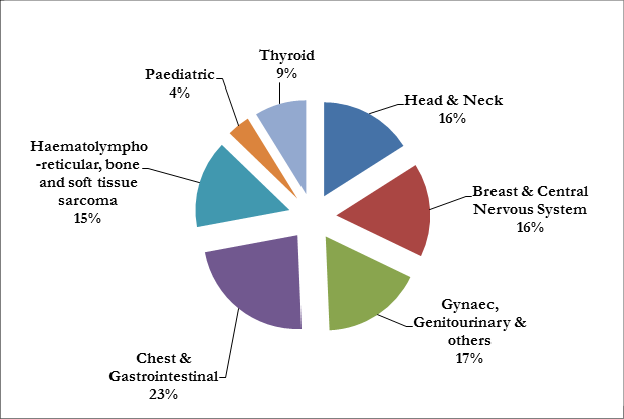
Source: Regional Cancer Centre, Thiruvananthapuram
The highest percentage of new cancer cases registered were related to Chest & Gastrointestinal cancers during the mean period and followed by Gynaec, Genitourinary and Breast & Central Nervous System cancers.
The data on the speciality clinic wise number of patients (new & review) who had undergone treatment during the year shows an increase in the number of new cases registered with respect to Chest & Gastrointestinal and Breast & Central Nervous System. Table 7.4 provides number of new and review Patients undergone treatment in speciality clinics in the year 2015-16.
Table 7.4
Speciality clinic wise number of patients (new & review) undergone treatment 2015-16
| Clinic | New | Review | Total | Chest & Gastrointestinal | 3702 | 33002 | 36704 | Gynaec, Genitourinary | 2708 | 31262 | 33970 | Breast & Central Nervous System | 2628 | 44502 | 47130 | Head & Neck | 2575 | 32147 | 34722 | Haematolymphoreticular, bone and soft tissue sarcoma | 2375 | 40666 | 43041 | Paediatric | 645 | 14728 | 15373 | Thyroid | 1409 | 19849 | 21258 | Total | 16042 | 216156 | 232198 |
Source: Regional Cancer Centre, Thiruvananthapuram
The details of the age and sex wise number of new cases registered reveals that people in the middle-ages are more prone to cancer diseases. About 29.19 per cent of male in the age group 55-64 are affected by cancer whereas the age group in the case of women is slightly lower than this, that is, 25.4 per cent female are affected by cancer during the years 45-54. Figure 7.8 illustrates age and sexwise new cancer patients registered for treatment in RCC in 2015-16.
Figure 7.8
Age and Sex wise new cases registered in 2015-16, in number

Source: Regional Cancer Centre, Thiruvananthapuram
System-wise (per cent) distribution of cancer patients by Gender
Table 7.5 depicts the system wise percentage distribution of cancer patients by gender. It is seen that incidence of oral cavity & pharynx cancer and cancers to respiratory system are mostly prevalent in men rather their female counterparts.
Table 7.5
System-wise percentage distribution of cancer patients by gender: HBCR, Regional Cancer Centre, Thiruvananthapuram, 2015-2016
| Male | Style | Female | 185 (2.6) | Brain & Nervous System | 116 (1.6) | 1315 (18.9) | Oral Cavity & Pharynx | 537 (7.4) | 315 (4.5) | Thyroid | 1059 (14.8) | 1305 (18.5) | Respiratory System | 228 (3.2) | 25 (0.4) | Breast | 2054 (28.7) | 602 (8.6) | Oesophagus & Stomach | 217 (3.0) | 848 (12.0) | Other Digestive Organs | 510 (7.1) | 290 (4.2) | Urinary Tract | 63 (0.9) | 390 (5.6) | Reproductive System | 1214 (16.9) | 300 (4.4) | Bone, Conn. tissue & Skin | 243 (3.4) | 711 (10.1) | Leukaemia & Myeloma | 520 (7.2) | 481 (6.9) | Lymphoma | 274 (3.8) | 258 (3.7) | All Others | 128 (1.9) |
Source: Regional Cancer Centre, Thiruvananthapuram
Notr: Figures in paranthesis denotes percentage
Referral System
RCC is a tertiary level referral hospital and patients were referred from other government and private hospitals. Most of the cases were referred from Thiruvananthapuram district, followed by Kollam, Malappuram, Palakkad, and Alappuzha. In addition to this, 1740 cases were referred from Tamil Nadu, 12 from Karnataka, 13 from Lakshadweep and 193 from other Indian States. 225 persons from Maldives were also referred during the year 2015-16.
Patient Welfare Schemes
The RCC charges only minimum or subsidised rate from low income patients. Patients are grouped into categories according to their socio-economic status and payment capacities. Table 7.6 gives category wise number of New Patients registered in RCC in 2015-16.
Table 7.6
Categories of new patients registered based on socio-economic status in 2015-16, in number and per cent
| Category | No. of Patients | Percentage | Minimum payment | 8513 | 53 | Subsidised payment | 4284 | 27 | Normal rate | 3246 | 20 | Total | 15,939 | 100 |
Source: Regional Cancer Centre, Thiruvananthapuram
The RCC has implemented several schemes for providing economic assistance, free food, free drugs and various rehabilitation facilities for patients and their families through governmental and non-governmental support programmes.
State Government Supported Schemes: Cancer Suraksha Scheme, Chis Plus, Karunya Benevolent Fund, Sukrutham, Thalolam, Scheduled Tribe Patient Fund, and Snehasanthwanam for Endosulfan Victims are some of the State Government supported schemes.
Central Government Supported Schemes: Prime Minister’s Relief Fund, Health Minister’s Rashtriya Arogya Nidhi (RAN), and Health Minister’s Discretionary Fund are some of the Central Government supported schemes.
Major initiatives of RCC
In addition to the Government supported schemes RCC provides support to patients and families through various other schemes as detailed below:
- Cancer Care for Life (CCL) Scheme – This is a health insurance scheme for cancer treatment. Considering the large response from the public, the RCC has been modifying the scheme. During the year 2015-16, 163 patients reported for treatment under the scheme.
- Free Drug Bank - The Free Drug Bank functions according to specific guidelines and is monitored by a committee constituted by the Director, RCC. The drug bank provided full or partial help to 4,630
patients during the reporting period. - Free Food (‘Akshayapathram’) - Free food was provided to 8400 patients belonging to low socio-economic status during the report period with the support of many philanthropic organizations.
- Support for Paediatric patients – ‘Prathyasa’, a voluntary group working in collaboration with Paediatric Oncology division gave financial and psychosocial support to children and their families.
- Indian Cancer Society Support Scheme - RCC was selected as one of the five cancer centres across India for receiving financial support from the Indian Cancer Society for treatment of cancer. During the report period, 175 patients including 12 new patients received support worth 196.66 lakhs.
Research and Development Activities
The RCC as a pioneer research institution in cancer research has produced several PhDs in Cancer Research. During the year 2015-16, around 25 scholars were pursuing PhD, 33 residents undertook specialisation in Medical, Paediatric and Surgical Oncology super speciality courses and 46 residents undertook postgraduate courses in Anaesthesia, Pathology, Radio diagnosis and Radiotherapy in the centre. The centre is also undertaking 155 research projects.
Cancer Control Activities
- Cancer awareness programmes: As part of cancer awareness programmes in the community, 58 cancer awareness programmes were conducted, which was attended by 6,000 people. These programmes were arranged mainly for high school/higher secondary school students and teachers, office staffs, lay public and vulnerable groups like the tribal population, fishermen community, and rural population.
- International School of Colposcopy: 16 doctors were given one-week hands on training and 30 BSc (MLT) students were given one day orientation programme on VIA, VILI and Colposcopy.
- Trainer-Trainee Programmes: 21 trainer-trainee programmes were conducted for health care providers which included doctors, post graduate medical students and paramedical staff from governmental and non-governmental institutions. 22 programmes were conducted for community volunteers from organisations/schemes such as the Kudumbashree and ICDS, public health training students, teachers and school students from various districts of the State.
Early cancer detection, 2015
During the period under report, 5940 persons attended the Early Cancer Detection Clinic of the Division. Oral biopsy was done for 61 patients (53 punch and 8 excision biopsies).
Cancer Outreach Programmes, 2015
102 cancer detection camps were conducted in various parts of the State in which 9478 people underwent screening. This included 24 cancer detection camps conducted among women residing in the Mangalapuram Breast Cancer Screening project area and seven camps in Idukki district.
The Swasthyam project
The RCC took the leadership role to train women volunteers of the Kudumbashree Mission in cancer prevention project initiated in Pathanamthitta district with the objective to sensitise households of Pathanamthitta district through the ‘Swasthyam project’. As part of this, two general sensitization cum motivation programmes and five trainer-trainee programmes were conducted by RCC to train 164 resource persons in cancer prevention activities. One of the main objectives was to motivate eligible subjects to undergo screening for common cancers or advise them to undergo diagnostic evaluation at hospitals if any warning signals of cancer were present.
Other Initiatives
Realising the increasing prevalence of tobacco and related substance abuse among adolescent school students in Kerala, the Centre has initiated several antitobacco education programmes at the high school and higher secondary school levels. World No Tobacco Day was observed on May 31st in collaboration with Sree Chitra Tirunal Institute for Medical Sciences and Technology, Directorate of Health Services, Tobacco Free Kerala, Kerala Voluntary Health Services, ADIC-India and the Regional Cancer Association. The Centre has also initiated school based intervention programme against tobacco and alcohol consumption in high school/higher secondary schools of rural Kerala. The objective of this programme was to understand the patterns of tobacco and alcohol use among students in the rural areas of Thiruvananthapuram district. It would provide an estimate on the prevalence and patterns of tobacco and alcohol use among adolescent school students.

